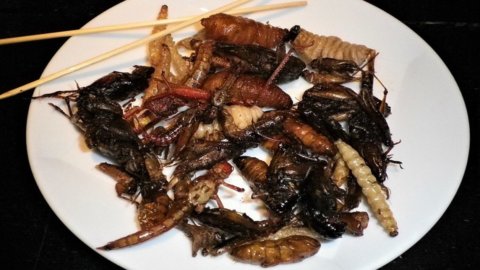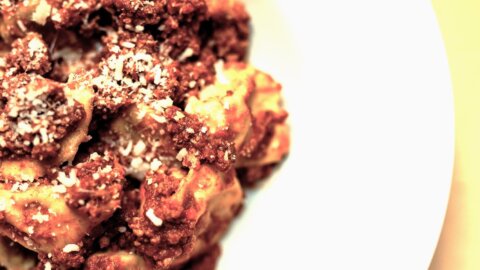Ravioli stuffed with moths, grasshopper skewers street food style, baked larvae: now different restaurants they insert into theirs menu dishes that use insects in their recipes. Between fashion, taboo and innovation in recent years theentomophagy, a diet based on insects.
If many Eastern countries eating insect-based dishes is customary and bans the tables of millions of families, in others, like us, this new gastronomic frontier causes much resistance and still arouses a lot of sensation, but at the same time it shakes the most innovative minds and intrigues several chefs, who have begun to familiarize themselves with this type of raw material in their restaurants.
Renè Redzepi and his recipes based on ants
The use of insects in human nutrition has been talked about for some years. Among the most famous chefs in the world to make dishes based on insects must be mentioned René Redzepi, which in his "Noma", a multi-starred restaurant in Copenhagen, offers dishes with bee and ant larvae. Just one of his dishes based on ants caused a lot of clamor, even on the web, because it was about ants served alive spiced with coriander and lemongrass leaf, crunchy and with a lemon flavour.
This is not the only proposal Redzepi. In fact, he also reduces the ants into jam, accompanies them with a blueberry crème fraiche between nasturtium leaves or serves them as an accompaniment to glazed cod head or makes a pesto with various spices. In short, the ants are declined in many versions for every type of curious customer.
Finally, scrolling through his Instagram profile, one finds a post with a type of ant that he usually eats in Australia and Mexico, worthy of curiosity and extravagance, so Redzef he's crazy about it.
The ants in question are overfed drop by drop with honey every day, until their body has reached eight times their normal weight. At this point they are ready to regurgitate the honey for the other ants. Redzepi it confirms its goodness and sweetness.
The use of insects in human nutrition, 2000 are edible
On 2018 January XNUMX, the EU regulation that regulates entomophagy came into force. Edible insects are considered a "nouvel food" with a high nutritional value, a complete food from a nutritional point of view and with a low environmental impact.
According to the regulation EU of 2018, insects such as Tebrio molitor (flour moth) and the migratory locust in dried form are considered edible, frozen and powdered.
In reality, there are about 2000 edible species for humans, but mainly in oriental countries, where entomophagy is part of the culinary culture, they are used grasshoppers, crickets, locusts, ants and cicadas. From a nutritional point of view they are characterized by proteins of high biological value similar to eggs, meat and fish. They are also a source of zinc, magnesium, phosphorus and iron.
It goes without saying that there are still some differences between one insect and another depending on the type of environment in which they were raised and the substances they fed on, but in principle the main characteristics are common.
Entomophagy and nutritional conversion of insects: a fact to reflect on for the future
Insects have aexcellent nutritional conversion. Suffice it to say that they are able to transform 2 kg of ingested food into 1 kg of body mass, unlike the bovine which needs 8 kg of food to increase its body mass by only 1 kg.
Another positive aspect is given by the conversion of the insect in the making of a dish. It is stated that approx 80% of a cricket gets on your plate, with a very minimal difference, unlike pork of which only 55% is used of its mass. It goes without saying that the quote "Nothing from the pig is thrown away" is not entirely correct.
THEentomophagy it not only has positive aspects on the ecosystem and health, but currently also has negative aspects such as the price. For a kilo of cricket flour costs around 100 euros. This happens because the demand from the consumer is still very limited and consequently also its production. Certainly if the production in the future will be industrial and on a large scale, the price per kilogram will also decrease.
Insects in pet food: the new frontier of nutrition for 4-legged friends
If to us this new food frontier causes some problems for i our animals who cannot choose what to eat, the problem does not arise: insects have also landed in the sector for some years pet food becoming part of the food of our friends a 4 legs.
It is not a question of fashion or ephemeral innovation, but of a type of diet that can be recommended by the veterinary surgeon, an expert in animal nutrition, in the course of suspected food intolerance or allergy. In this case, the veterinary surgeon will recommend a dietary change, based on a new protein source, an alternative to those already taken, but equally valid. The inclusion of a new protein source or “new proteinshouldn't trigger immune responses by the body and be well tolerated, leading to the resolution of dermatological and/or gastrointestinal problems with which they manifest themselves. Since many pet food present a mix of animal proteins, a commercial insect-based food can be a valid alternative for a food test in our 4-legged friends and in recent years discreetly embraced by the consumer.
Europe is still reluctant but in 140 countries of the world it is a common fact
THEinsect food seems to still be little accepted in Europe, even if it is one innovative food style and from less impact on the global ecosystem. Eating insects, in about 140 countries around the world, is common and does not cause a sensation. In the future perhaps, becoming more and more part of the Western food culture, you can choose to munch on Hormigas culonas, a type of ant, at the cinema instead of popcorn, a snack already widespread in Thailand or have an aperitif with friends sipping a bee cocktail or after dinner with a glass of Vodka enriched with silkworms.
Finally, the estimates of the are not to be underestimated FAO, which show how the consumption of insects could be an effective way to feed the entire world population, which is estimated to reach almost 10 billion in 2050.





